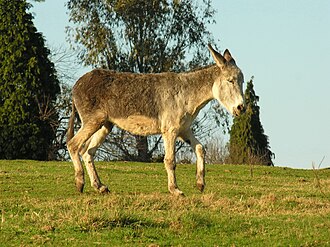Latest revision as of 18:26, 15 April 2021
Information about message (contribute ) This message has no documentation.
If you know where or how this message is used, you can help other translators by adding documentation to this message.
Message definition (AY Honors/Livestock/Answer Key )
</noinclude>
</noinclude>
<!-- 4. Identify a burro from a picture or live. Give its size, color, and usefulness. -->
[[Image:Burro Sigueiro Oroso Galiza 1.jpg|thumb|300px|Burro]]
The Spanish brought donkeys, called "burros" in Spanish, to North America, where they were prized for their hardiness in arid country and became the beast of burden of choice by early prospectors in the Southwest United States. In the western United States the word "burro" is often used interchangeably with the word "donkey" by English speakers. Sometimes the distinction is made with smaller donkeys, descended from Mexican stock, called "burros," while those descended from stock imported directly from Europe are called "donkeys."
<br style="clear:both">
The Spanish brought donkeys, called "burros" in Spanish, to North America, where they were prized for their hardiness in arid country and became the beast of burden of choice by early prospectors in the Southwest United States. In the western United States the word "burro" is often used interchangeably with the word "donkey" by English speakers. Sometimes the distinction is made with smaller donkeys, descended from Mexican stock, called "burros," while those descended from stock imported directly from Europe are called "donkeys."

